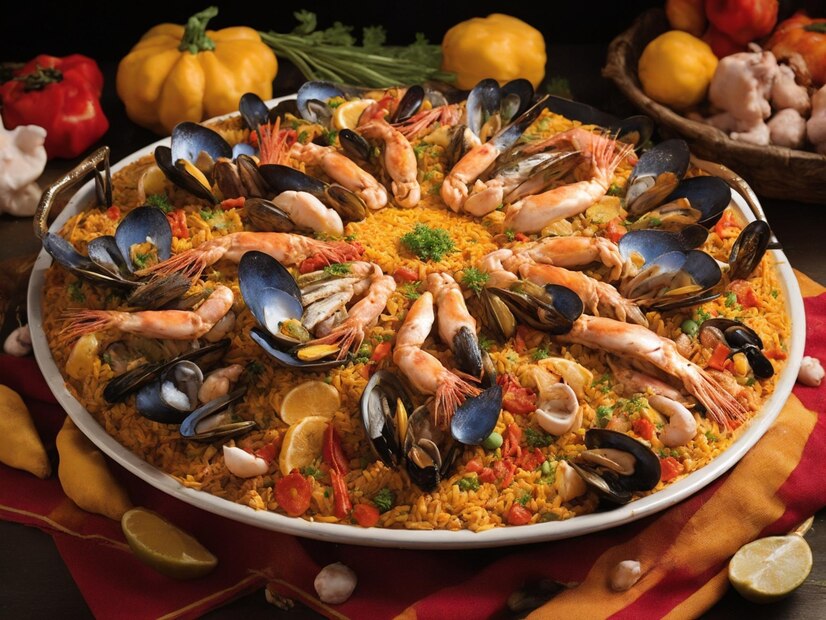In the realm of Spanish cuisine, few dishes hold as much cultural significance and gastronomic appeal as paella. This iconic dish, originating from the region of Valencia, has captivated food enthusiasts worldwide with its vibrant colors, rich flavors, and diverse ingredients. From its humble beginnings as a peasant’s meal to its evolution into a symbol of Spanish culinary prowess, paella embodies the essence of Spanish culture and tradition. In this comprehensive exploration, we delve into the history, ingredients, regional variations, and preparation techniques of paella, uncovering the secrets behind its enduring popularity.
A Brief History of Paella
Origins in Valencia: Tracing the roots of paella to the rice fields of Valencia, where it was first created by farmers and laborers as a hearty one-pot meal cooked over an open flame.
Evolution and Adaptation: The evolution of paella over centuries, influenced by various cultural and culinary influences, including Moorish, Roman, and Mediterranean traditions.
Cultural Significance: Paella as a symbol of community, celebration, and hospitality in Spanish culture, often served during festivals, weddings, and family gatherings.
Essential Ingredients of Paella
Rice Varieties: Exploring the different types of rice used in paella, such as Bomba, Calasparra, and Senia, prized for their ability to absorb flavors while retaining a firm texture.
Saffron: The “gold” of Spanish cuisine, saffron lends paella its distinctive color and aroma, infusing the dish with depth and complexity.
Proteins: Traditional paella ingredients include chicken, rabbit, and seafood, though modern variations may incorporate other meats such as duck, chorizo, or even vegetarian alternatives.
Vegetables and Aromatics: Bell peppers, tomatoes, onions, garlic, and peas add layers of flavor and freshness to paella, complementing the richness of the other ingredients.
Regional Variations of Paella
Valencian Paella: The authentic version of paell’a, known as “Paell’a Valenciana,” typically features chicken, rabbit, snails, and vegetables, reflecting the agricultural heritage of the region.
Seafood Paella: A coastal adaptation of paell’a, abundant with a variety of fresh seafood such as prawns, mussels, clams, and squid, capturing the essence of Spain’s maritime bounty.
Mixed Paella: Combining land and sea, mixed paell’a incorporates both meat and seafood, offering a harmonious blend of flavors and textures that appeal to a wide range of palates.
Vegetarian Paella: Catering to dietary preferences, vegetarian paell’a showcases the bounty of Spain’s fertile lands, featuring an array of seasonal vegetables and aromatic herbs.
The Art of Paella Preparation
Traditional Cooking Methods: Exploring the traditional techniques of cooking paell’a over an open flame, using a wide, shallow pan known as a “paellera” to achieve the perfect balance of flavors and textures.
Socarrat: The prized caramelized crust that forms on the bottom of the paell’a, adding depth and complexity to the dish, and symbolizing culinary mastery.
Seasoning and Spices: Balancing flavors with a careful selection of spices and herbs, such as paprika, rosemary, thyme, and bay leaves, to enhance the natural essence of the ingredients.
Serving and Presentation: The art of serving paell’a communal-style, straight from the pan to the table, creating a festive atmosphere and fostering conviviality among diners.
Paella Beyond Spain
Global Influence: The spread of paell’a beyond Spain’s borders, gaining popularity in countries around the world and inspiring countless interpretations and adaptations.
Fusion Cuisine: Innovative chefs incorporating elements of paell’a into fusion cuisine, blending Spanish flavors with culinary traditions from other cultures to create unique and exciting dishes.
Culinary Tourism: The rise of paell’a tourism, with travelers flocking to Spain to experience authentic paell’a firsthand, participating in cooking classes, and savoring the diverse regional variations.
Conclusion
Paell’a stands as a testament to the rich tapestry of Spanish culinary heritage, embodying the spirit of tradition, innovation, and conviviality. From its humble origins in the rice fields of Valencia to its global acclaim as a culinary icon, paell’a continues to captivate the hearts and palates of food enthusiasts worldwide. Whether enjoyed in a rustic tavern in Spain or recreated in kitchens around the globe, paell’a remains a symbol of culinary excellence and cultural pride, inviting all who partake to savor the flavors of Spain’s vibrant culinary landscape.







